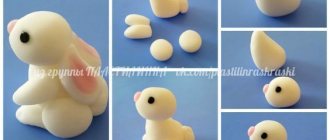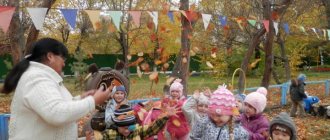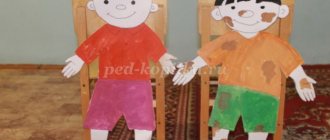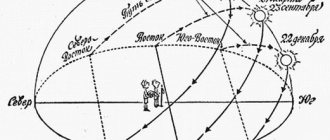Walks. Walking notes - RPPS of the walking section of the early age group
Publication “RPS of the walking section of the early group...”
Last year, we took courses “Organization of a subject-development environment for the implementation of the Federal State Educational Standard for Education,” where the final task was to analyze the developmental subject-spatial environment of our walking area, outline the prospects for renovation and turn them into reality...
Summary of an open lesson in the second early age group “Walk to the Zoo” Summary of an open lesson in the second early age group “Walk to the Zoo” Program content: 1. Contribute to expanding knowledge about animals, their appearance, habits. 2. Reinforce concepts: one-many; knowledge of primary colors. 3. Develop speech, enrich...
Project in an early age group “Healthy walk for mothers and babies” Municipal educational institution “Gymnasium No. 9” Preschool department, building No. 5 Project in an early age group “Healthy walk for mothers and babies” Educator: Semenova S. N. g.o . Elektrostal 2021 Relevance of the project. Children's stay in the fresh air has...
Passport for the walking section of the early age group of the municipal budgetary preschool educational institution "Kindergarten No. 35" Passport of the walking section of the group No. 1 (early age group) Educators: Pechkina E.A., first quarter category Lunina N.M., first quarter category Arzamas, 2021 The purpose of organizing a walking tour…
Junior group. Early childhood, nursery. Children 1-4 years old
Summary of the lesson for young children “Chickens for a walk” Meta: Formulate children’s knowledge about spring (sun, spring, listen to the teacher with respect, repeat the call about sun, confirm the power supply; learn and correctly name the main colors (red, yellow) , green, blue, manipulate objects. Lock...
Summary of educational activities for familiarization with the outside world in the second group of early age “Let's help the animals get ready for a walk” Objectives: To cultivate responsiveness. “clothing” in children’s dictionaries
.
Materials: hats, scarves, toy dog, bear and bunny. - Guys, let's help the dog, the bear and the bunny get ready for a walk . The dog came running first...
Move
The teacher invites the children to turn into fairy-tale characters - piglets. He puts hats on the children and invites them to go to a fairy meadow. The children are walking, and suddenly a “wolf” appears.
The game is played: “Let’s run away from the wolf.”
Fleeing from the wolf, the piglets were very tired and decided to drink tea. Everyone sits down at the table, one child (prepared before class) goes to get the kettle, and a desperate squeal “Ay - ah - ah” is heard. I burned myself, the kettle is very hot.
Educator. You see guys, if you handle hot objects carelessly, you can get seriously burned. She calms the piglets and pours tea herself, explaining that only an adult should pour hot tea or soup, etc. After drinking tea, the piglets go back to the clearing.
Physical school
Like on a typewriter Two pretty pigs Knock - knock - knock - knock! Knock - knock - knock - knock!
And they tap and grunt: Grunts - grunts - grunts - grunts! Grunts - grunts - grunts - grunts!
(At first the pace with light hand movements is not fast, then everything becomes “playful”, faster, the children type as if on a computer).
The teacher sits the children down again. He suggests looking at posters depicting dangerous situations with a lighter, hair dryer, screwdriver, iron, and explains what dangers there may be in the house from these electrical appliances. If handled incorrectly, they may cause electric shock or cause a fire. Then the teacher asks questions about the pictures.
- What electrical appliances do you see in the picture?
- What does the fireman say about the lighter?
- What can happen if you don’t turn off the iron and plug a screwdriver into the socket.
The teacher consolidates the conversation with the words:
“Never touch, turn on, play with, or turn off these electrical devices - because this is life-threatening.” And if any of these electrical appliances are left not turned off and you leave the house, a fire may occur. And in a fire, things, an apartment, and even a whole house can burn down.
He reads a poem: If you turn on the iron, you don’t need to suddenly run away. When you close the door in the house, check if you turned everything off!
A fire can also occur if you play around with matches. Light candles or sparklers without permission or adult supervision.
Next, the teacher reads the poem: You should never play around with matches. You can start a fire very quickly.
Shows a picture of a fox playing with matches and asking questions to children (choral and individual answers).
Please tell me, if a fire suddenly happens, what should be done.
Gives hints to children. We need to call the firefighters. Dial number 01 . (Shows the poster). They will arrive in a fire truck and put out the fire. Offers to look at pictures of a fire truck and firefighters. Enter your phone number and car name.
Educator. Well, now I think you have learned what can cause a fire. I think you will do the right thing. And now you can go on for a walk to the fairy meadow.
Baba Yaga appears.
Baba Yaga. Yeah, you got caught, so I won’t let you go anywhere now.
Educator. Let Grandma Yaga let us through, and we’ll sing you a song.
Song-game: “Baba Yaga”
Introduction: children stand in a circle, Baba Yaga in the center.
1. There is a hut in a dark forest, standing backwards. There is an old woman in that hut: Grandma Yaga lives. Children walk in a circle holding hands. Losing: children show their nose.
2. Her eyes are big, like lights are burning. Children make “beaks” with their hands. Wow, how angry. The children squat down and make a terrible grimace. My hair stands on end. Children stand up, raising their hands up. After the loss, Baba Yaga catches up with the children.
Baba Yaga. It’s my nose that’s crooked, it’s me who’s angry, I won’t let you go anywhere.
Now, if you just complete my task correctly, then maybe I’ll let you go. Baba Yaga gives the children the following task:
- Find in the picture objects that children can play with and which they cannot.
Children take turns showing each other to help if the answers are not correct.
Educator. Well, Baba Yaga, did the children cope with your task or not?
Baba Yaga. Well done, you did everything right, now go to your clearing.
The children come out and invite Baba Yaga to dance. After the dance, Baba Yaga treats the children to bagels, boasting that she baked them herself. Says goodbye and leaves.
The teacher invites the children to return to the group.
Summary of GCD in the younger group with presentation. Theme: Winter walk
ECD in the junior group “Winter walk”
Topic: “Winter walk” Safe behavior while walking in the winter season Objectives: 1. To reinforce children’s ideas about the rules of safe behavior in winter outside (you need to dress warmly, you cannot eat snow, stand under icicles). 2. Foster a sense of caution and self-preservation. 3. Strengthen children’s ideas about natural phenomena in winter (it’s snowing, the wind is blowing, it’s getting cold). 4. Continue to awaken children’s speech activity in class. Preliminary work: reading fiction about winter; observing the signs of winter; Integration of educational areas: “Safety”, “Cognition”, “Communication”. Types of children's activities: gaming, communicative, cognitive. Methods and techniques: questions from the teacher, the game “Getting Dressed for a Walk,” the story game “On a Walk,” musical accompaniment, the game “It’s frosty and windy outside,” looking at illustrations. Materials and equipment: stereo system, audio recording of snow creaking, wind noise, children's crying, doll in a light dress, doll crib, blanket, presentation. Progress of the lesson Organizational moment. Educator: Guys, please tell me what time of year it is now? Children: Winter. Educator: That's right, now it's winter outside, and what is it like, please describe it. Children: Snow-white, beautiful, cold. Educator: Do you like to walk in winter? Children: We love to walk in winter. Educator: What games do you like to play? Children: Ride down the ice slides, sled, build a snowman, play snowballs... Educator: Do you know where we can play and where we can’t? Children: You can only play in the yard or on the playground, you cannot play near the road. Educator: Correct. Educator: Guys, today we will go on an unusual walk. But before we go outside, we must dress warmly, because in winter it is very cold outside. Let's all stand in a circle together and start “getting dressed” Game “Getting Dressed for a Walk”. Now it’s winter outside, (We spread our arms to the sides) It’s cold (we cross our arms over our chests) But we don’t care about the frosts (“we shake” our fingers) We’ll go for a walk with you. (step in place) We will put on pants, (we run our palms over our legs from bottom to top) We will put on fur coats, (we run our palms along our torso from top to bottom) And we will put on hats, (we stroke our heads with our hands) We will tie scarves, (we stroke our necks) And then beautiful, (we stroke our hands one by one) Warm, fluffy Little mittens We’ll put them on our arms, And although we are small, (we put out first one leg, then the other) We all have felt boots. Story game “On a walk” Educator: We dressed warmly, now I suggest we go for a walk. It's slippery outside in winter, so you have to walk carefully and slowly to avoid falling. (Audio recording of snow creaking underfoot). Guys, did you guess that this is creaking under our feet? Children: Snow. Educator: That's right, it's snow. So we came to our site. (The audio recording is turned on - the hum of the wind). Oh, why did it blow so much? Children: It's the wind. Educator: Yes. This is the wind, it is very cold. It’s cold outside in winter, the snowy wind tries to get into your sleeves and collar, your cheeks get cold, your nose freezes. To stay warm, we need to play. Game “It's frost and wind in the yard” It's frost and wind in the yard Children are walking in the yard, (walking in place) They're rubbing their noses, their cheeks are warming up. (to three cheeks) Little hands will not freeze, (to three hands) We will clap our hands. This is how we can clap, This is how we warm our hands. (clap our hands) So that our feet don’t get cold, We stomp a little. This is how we know how to stomp, This is how we can warm our feet. (stomp our feet) (Audio recording of a child crying). Educator: Hear, someone is crying, let's look around, who is it? (A doll sits on a bench.) Look guys, this is a doll. -What's your name, doll? Doll: My name is Katya. Educator: Why are you crying so bitterly? Doll: So, I went out for a walk and was very cold. Educator: Look, children, why is Katya frozen? Children: She forgot to put on warm clothes, sits on a bench, doesn’t play. Educator: Correct. Katya needed to dress warmly and play and run. Katya, you can catch a cold and get sick, you need to go to the group and warm up. Guys, let's go to the group and explain to Katya how to behave outside in winter. Katya, do you agree? Doll Katya : Yes. Educator: Guys, let's go carefully, slowly. So we entered the group, now we take off our outerwear and carefully put them in lockers. And we’ll cover Katya with a blanket. Educator: Guys, let's tell Katya the rules on how to behave outside in winter. Learning the rules . 1. During a walk in winter, you cannot sit or stand for a long time without moving, because... You can freeze and catch a cold. We need to play, walk or run. (2nd slide) 2. In winter, the street is slippery, you can fall. We must walk carefully, at a slow pace. (3rd slide) 3. You can’t eat snow, because... Your throat and stomach may hurt. (4-5 slide) 4. You cannot stand under the icicles that hang from the roofs of houses, because they can fall and cause serious injury. And yet, you can’t lick the icicles, otherwise your throat will hurt. (6 slide) 5. You need to take turns going down the slide. Wait until your friend slides down the slide and moves aside, and then you slide down too. Otherwise, you might run into each other and get bumps on your forehead. (7 slide) Educator: Katya, did you remember the rules on how to behave outside in winter? - Yes. Thank you guys. Educator: Yes, you are great. Guys, be careful outside in winter. And you, Katya, take care of yourself. I invite the doll Katya to stay in our group. Reflection Educator: Guys, what did you like most about our walk today?
What dangers await us while walking and how to avoid them? Presentation on the topic: Winter safety rules
We recommend watching:
Abstract of an educational activity on sensory development in the younger group on the topic: Winter Abstract of an integrated lesson in the 2nd junior group on a winter theme Synopsis of educational activities for cognitive development for children of the second group of early age "Winter travel" Abstract of an educational activity on drawing in the second junior group on the topic "Christmas tree"
Similar articles:
Summary of a game lesson for young children on the topic: Winter




